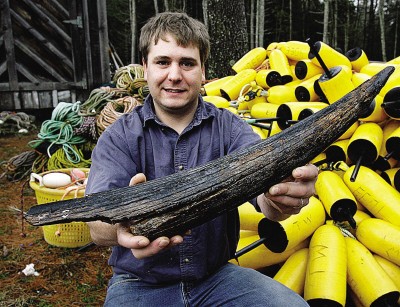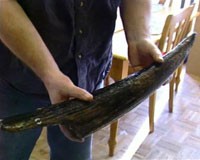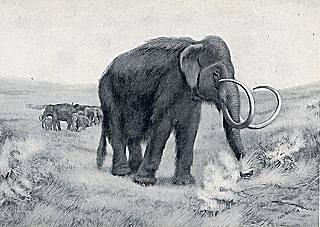Mystery Tusk: Not A Circus Elephant
Posted by: Loren Coleman on January 8th, 2007

Fisherman Tim Winchenbach poses outside his home in Cushing, Maine, with a mysterious prehistoric tusk that was pulled up with a load of scallop shells on a New Bedford vessel fishing off Georges Bank in December 2006. Photos by Joel Page.
Does this tusk come from a ten-thousand-years or older, long gone mammoth or mastodon? Along the coast of Maine, the news of this find has been a strange but popular story in the papers, on the local television channels, and of some note to lovers of curios and fossils. It is, needless to say, not especially cryptozoological, unless the tusk turns out to be of recent origin or not of a mammoth or mastodon. However, it is mostly an intriguing tale of what kind of weird thing might turn up in your next net of scallops.
The following is a summary of extracts from three local sources published in Portland.

Look What I Found!
One of the first in the media to break the story was Rhonda Erskine at WCSH-TV, who wrote a story on January 4, 2007, entitled “Maine Fisherman Makes Mammoth Find.”
Here’s part of what she wrote:
A fisherman from Cushing recently caught more than he expected off Georges Bank, and now wants to find out what it really is. Tim Winchenbach was working on a scallop dragger when he found what appears to be a wooly mammoth’s tusk….
Winchenbach says he has seen whale bones before, and is convinced its not that or any other sea creature. Now he and his family are waiting for some experts to see it for themselves. They have sent photos of the tusk to a researcher at the Maine State Museum.
“I thought it could be a walrus tusk, but they’re different shape like oval shape and this is perfectly round and a lot bigger around,” said Winchenbach.
“Just the thought that I’ve held something potentially 10,000 years old or older, and nobody else in the world has touched it before us. I find it really fascinating,” said Winchenbach’s wife Michelle.
Tim and Michelle say once they find out for sure what it is, they will probably donate the tusk to a museum, where it can be properly preserved.

An old drawing of a mammoth. In North America, various species of mammoths existed, including three large species – woolly mammoth, (Mammuthus primigenius), Columbian mammoth (Mammuthus columbi), and Jeffersonian mammoth (Mammuthus jeffersonii) – and one small-sized species – the pygmy or Channel Islands mammoth (Mammuthus exilis).
More Discovery Details
On January 6, 2007, Don Cuddy of the Standard Times wrote about the incident in an article entitled, “Mammoth find by city scalloper? Tusk identified as 13,000 years old pulled out of Georges Bank”:
A routine fishing trip took an exotic turn last month when a New Bedford scalloper brought up a 13,000-year-old tusk along with its catch. The fishing vessel Celtic was dredging on Georges Bank in December when one of the crew spotted a dark object protruding from the pile of scallops dumped on deck. Deckhand Tim Winchenbach at first thought he was looking at an old piece of wood, but after tapping it on the deck he realized that it was something much more intriguing.
Now it appears that his find, preserved through the ages in the clay bottom, may actually be a tusk from the long-extinct woolly mammoth.
“It was pretty rough when we got it aboard so I just stuck it in my sea bag till we came back,” he said. “But it has to be kept in fresh water for a long time and then dried out slowly so it doesn’t break.”
Mr. Winchenbach, 31, who lives in Cushing, Maine, said he kept the tusk under the “finders keepers” rule observed on the scalloper.
“The other guys didn’t think it was any big deal,” he said.
He arrived back in New Bedford on Dec. 21 from the 17-day trip and brought it home to his wife, Michelle. She decided to look for expert help in identifying the tusk.
“We took some photos and sent them to the Maine State Museum in Augusta,” Ms. Winchenbach said. “Based on the coloration, they say it’s definitely about 13,000 years old.”
Paula Work, zoological curator at the museum, looked at the pictures and confirmed the tusk is the real thing.
“This has been very exciting for the museum. It’s definitely Pleistocene, which is the Ice Age, and my gut feeling is that it’s from a mastodon,” she said. “But I can’t confirm that until I have actually seen it for myself. If it’s not a mammoth or a mastodon, the only other possibility is a giant bison.”
While woolly mammoths may fire the popular imagination, it would be even more exciting if the tusk came from a mastodon, Ms. Work said.
“Woolly mammoths roamed in the open while mastodons preferred woodland areas. This would be more evidence to support the theory that the area now below Georges Bank was once all woodland.”
Although comparatively rare, the tusk’s value is mainly scientific, she said.
“Since they opened up the Siberian plateau, there has been a lot more coming on the world market,” she said….

This old drawing says this is of an American mastodon. Mastodons (Mammut americanum) are members of the extinct genus Mammut and form the family Mammutidae; they resembled, but were different from, the woolly mammoth which belongs to the family Elephantidae. Indeed, the domed head on this drawing seems to indicate this is a misidentified wooly mammoth.
A Circus Elephant?
Finally, the Portland Press Herald printed the Associated Press account of January 6, 2007, via their article “Tusk from sea investigated.”
Most of the details are in the other articles, but a few tidbits – such as the recent story about that old chestnut of an-out-of-place “circus elephant” – are new:
…Fisherman Tim Winchenbach of Cushing brought the piece home to his wife, Michelle, who began researching to see if it could be from a wooly mammoth. “I was looking for some different pictures to compare it to, and there’s been a couple it looks very similar to,” she told WCSH-TV in Portland. “So it kind of reinforced our thoughts it could be (a mammoth).”
Remains of the extinct breed of elephant, which had a covering of long hair, have been found in North America, Europe, Africa and Asia. Mammoths lived from 1.6 million years ago to around 10,000 years ago.
The tusk of an elephant unearthed in 1959 by a man digging in a pit in Scarborough was first believed to be that of a circus elephant that was destroyed in 1816.
However, after the tusk was acquired by the Maine State Museum, carbon dating indicated it was a mammoth’s.
Professor Bill Glanz of the University of Maine’s Department of Biological Sciences said a wooly mammoth or mastodon could have lived in the Georges Bank area 13,000 years ago. The animals survived the ice age when that area was dry land and New England was covered by thick ice, he said.
Michelle Winchenbach is waiting for answers about her husband’s find, but she already feels the thrill of holding something so old.
“Just the thought that I’ve held something that’s potentially 10,000 years old or older, that nobody else in the world touched before us, I find it really fascinating,” she said. “I think it’s great.”
Mastodon Versus Mammoth
Description American mastodons are sometimes confused with their relatives- elephants and mammoths. All three, placed within the order Proboscidea, are large, heavy mammals with distinctive flexible trunks and tusks.
Mastodons were smaller than mammoths. Similar in size to modern-day elephants, with a height of 7 feet (2.1 meters) for females or 10 feet (3.1 meters) for males, adult mastodons weighed as much as 6 tons (5443 kg).
American mastodons had low-domed heads, unlike the higher-domed heads found in mammoths and modern-day Indian elephants. The tusks were less curved than those of mammoths but larger and longer than elephant tusks. Young male mastodons often displayed a short pair of secondary tusks in the lower jaw that were lost as they matured.
However, the most distinctive feature differentiating mastodons from mammoths is their cheek teeth. Unlike modern elephants and extinct mammoths, the mastodon had molars that featured distinctive, cone-like cusps. Mammoths had flat, ridged molars that look like washboards, totally different in appearance from mastodon teeth. These unusual cusped teeth give the mastodon its name, derived from the Greek (“mastos” for breast and odon(t) for tooth).
From the San Diego Natural History Museum.
Although their skeletons differ from each other as much as each differs from the modern elephant, the easiest distinction between them is in their teeth. Mastodons have teeth with blunted points, with which they easily crushed sticks and twigs in their diet—and for this reason some early paleontologists believed the mastodon to be a carnivore, and because of its great size, perhaps even a predatory one. The teeth of mammoths are flatter, with undulating, parallel ridges well suited for grinding the grasses that comprised its diet.
From Discovering Lewis and Clark by Earle E. Spamer and Richard M. McCourt.
About Loren Coleman
Loren Coleman is one of the world’s leading cryptozoologists, some say “the” leading living cryptozoologist. Certainly, he is acknowledged as the current living American researcher and writer who has most popularized cryptozoology in the late 20th and early 21st centuries.
Starting his fieldwork and investigations in 1960, after traveling and trekking extensively in pursuit of cryptozoological mysteries, Coleman began writing to share his experiences in 1969. An honorary member of Ivan T. Sanderson’s Society for the Investigation of the Unexplained in the 1970s, Coleman has been bestowed with similar honorary memberships of the North Idaho College Cryptozoology Club in 1983, and in subsequent years, that of the British Columbia Scientific Cryptozoology Club, CryptoSafari International, and other international organizations. He was also a Life Member and Benefactor of the International Society of Cryptozoology (now-defunct).
Loren Coleman’s daily blog, as a member of the Cryptomundo Team, served as an ongoing avenue of communication for the ever-growing body of cryptozoo news from 2005 through 2013. He returned as an infrequent contributor beginning Halloween week of 2015.
Coleman is the founder in 2003, and current director of the International Cryptozoology Museum in Portland, Maine.










I applaud Mr. Wichenbach and his wife for showing a truly inherent interest in a great piece of Pleistocene history and taking the time and effort to have it analyzed. I hope the fruits of their labor pay off. A really nice and enlightening post Loren. Thanks.
Judging by the remarks of his fellow scallopers, it is a good thing he had the presence of mind not to throw it overboard.
Thanks for sharing that Loren!
Pleistocene-age proboscidian tusk and teeth come off the continental shelves are so common as to scarcely draw comment in the scientific community. Finds come from all along the eastern coastline.
Saying “Circus elephant” might sound more reasonable to some sceptic, but it really is not. Several finds of whale bones inland are of Ice Age vintage and sceptics that do not know any better deny that they can possibly be fossils. Merely coming up with an explanation for something does not make the explanation a reasonable one.
BTW, I have seen pieces of mastodon tusks pulled out of an Indiana bog before, and several examples of associated fossils were in a display case where I used to work at the IUPUI library. Those pieces of ivory looked exactly like this piece.
I never realised mastadons were a different family from elephants and mammoths. How do we know, and what is it that distinguishes the two families?
Just curious.
Thanks
Okay, in response to this mammoth versus mastodon confusion, I updated the blog by adding some notes on their differences.
If my memory serves me correctly…
A mammoth molar was found in a net off Hampton Beach a few years back.
Here’s an interesting article about New Hampshire’s sunken forest.
Here’s another interesting article.
I really love the Pleistocene. The one thing I’m really hoping for is a new megalania fossil from Australia.
Great article Loren! Also excited to see an article from the “Sub-Standard Times” – the periodical of choice from my neck of the woods. There is a lot of really interesting whaling and scalloping history in New Bedford and there are a lot of good stories about mysterious things found out at sea.
Just an interesting thought here. Has anyone heard anything about the mammoth DNA they were extracting from frozen mammoths from Siberia? I heard they were thinking of doing some cloning.
Makes me want to take a walk on the beach at low tide sometime. I know some fossil crustaceans have been found along the shore of West Haven.
Things like this are commonly dredged up from the North Sea.
Our local museum has a mammoth tusk from the gravel pits.
They are fairly common.
Of course in GB its likely to be a common-or-garden wooly (or a straight tusked elephant if you are in an interglacial) we don’t have the variety of species to ponder on.
My guess is Walrus, possibly from the old mating grounds on Sable Island. Too straight looking for either Mammoth or Mastodon. Is DNA a possibility?
To determine if this is from a mammoth one would cut a section across its axis and examine the angle that the Shreger lines (cross hatched or stacked chevron patterns that result from the pattern of deposition for dentin and cementum which comprises the tusk’s original material) that one can see when the section is properly prepared (polished). Additionally, if it is walrus (it’s hard to tell from the photos, and there are really big Walrus tusks out there) the interior region of the ivory would display an “oatmeal” pattern when observed. I’m unfamiliar with the diagnostic criteria for mastodonts but samples I have seen display a similar kind of concentric structure in cross section. No doubt a competent vertebrate zoologist with experience in pleistocene animals would be able to reference other samples to more finely determine its origins. It’s fascinating because it underscores just how widespread these creatures, both proboscids and walrus, were not all that long ago. It’d be great to see ’em back in their old stompin’ grounds.
Wow, what I wouldn’t give to be in his shoes! And to think, I get really excited when I find an old seashell or cool stone at the beach. I totally agree with his wife’s comments!
Nice article, thanks!